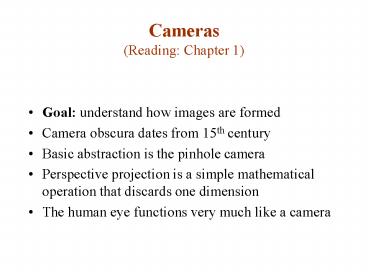Cameras (Reading: Chapter 1) - PowerPoint PPT Presentation
Title:
Cameras (Reading: Chapter 1)
Description:
Perspective projection is a simple mathematical operation that discards one dimension ... Spherical aberration ... Chromatic aberration ... – PowerPoint PPT presentation
Number of Views:28
Avg rating:3.0/5.0
Title: Cameras (Reading: Chapter 1)
1
Cameras(Reading Chapter 1)
- Goal understand how images are formed
- Camera obscura dates from 15th century
- Basic abstraction is the pinhole camera
- Perspective projection is a simple mathematical
operation that discards one dimension - The human eye functions very much like a camera
2
Camera Obscura
"When images of illuminated objects ... penetrate
through a small hole into a very dark room ...
you will see on the opposite wall these objects
in their proper form and color, reduced in size
... in a reversed position, owing to the
intersection of the rays". Da Vinci
http//www.acmi.net.au/AIC/CAMERA_OBSCURA.html
(Russell Naughton)
Slide credit David Jacobs
3
Jetty at Margate England, 1898.
http//brightbytes.com/cosite/collection2.html
(Jack and Beverly Wilgus)
Slide credit David Jacobs
4
First known photograph
5
Pinhole cameras
- Pinhole camera - box with a small hole in it
- Image is upside down, but not mirrored
left-to-right - Question Why does a mirror reverse left-to-right
but not top-to-bottom?
6
Pinhole camera in 2D
X (f / Z) X
7
Pinhole camera in 2D (with reflected image plane)
The image is the same after reflection of the
image plane, except that image is the right way
up!
8
Distant objects are smaller
Size is inversely proportional to distance.
9
Parallel lines meet
Example of the film plane drawn in front of the
focal point. Moving the film plane merely scales
the image.
10
Vanishing points
- each set of parallel lines meets at a different
point - The vanishing point for this direction
- Sets of parallel lines on the same plane lead to
collinear vanishing points. - The line is called the horizon for that plane
- Good ways to spot faked images
- scale and perspective dont work
- vanishing points behave badly
11
Slide credit David Jacobs
12
Properties of perspective projection
- Points project to points
- Lines project to lines
- Planes project to the whole or half image
- Angles are not preserved
- Degenerate cases
- Line through focal point projects to a point.
- Plane through focal point projects to line
13
The equation of perspective projection
14
Weak perspective
Assume object points are all at same depth -z0
15
Orthographic projection
16
Pros and Cons of These Models
- Weak perspective (including orthographic) has
simpler mathematics - Accurate when object is small relative to its
distance. - Most useful for recognition.
- Perspective is much more accurate for scenes.
- Used in structure from motion.
- When accuracy really matters, we must model the
real camera - Use perspective projection with other calibration
parameters (e.g., radial lens distortion)
17
Why not use pinhole cameras? If pinhole is too
big - many directions are averaged, blurring
the image Pinhole too small- diffraction
effects blur the image Generally, pinhole
cameras are dark, because a very small set of
rays from a particular point hits the screen.
18
The reason for lenses
19
Snells law
- n1 and n2 are the indices of refraction of each
material
20
Pinhole model with a single lens
- A lens follows the pinhole model for objects that
are in focus.
21
An out-of-focus lens
An image plane at the wrong distance means that
rays from different parts of the lens create a
blurred region (the point spread function).
22
Spherical aberration
Historically, spherical lenses were the only easy
shape to manufacture, but are not correct for
perfect focus.
23
Lens systems
- A good camera lens may contain 15 elements and
cost a thousand dollars - The best modern lenses may contain aspherical
elements
24
Vignetting
- Human vision is quite insensitive to slow change
in brightness. - However, computer vision systems may be affected.
25
Other (possibly annoying) phenomena
- Chromatic aberration
- Light at different wavelengths follows different
paths hence, some wavelengths are defocussed - Scattering at the lens surface
- Some light entering the lens system is reflected
off each surface it encounters (Fresnels law
gives details) - Cameras coat the lens, interior
- Human vision lives with it (various scattering
phenomena are visible in the human eye) - Geometric phenomena (radial distortion, etc.)
26
Human Eye
- The eye has an iris like a camera
- Focusing is done by changing shape of lens
- Retina contains cones (mostly used) and rods (for
low light) - The fovea is small region of high resolution
containing mostly cones - Optic nerve 1 million flexible fibres
http//www.cas.vanderbilt.edu/bsci111b/eye/human-e
ye.jpg
Slide credit David Jacobs
27
CCD Cameras
http//huizen.ddsw.nl/bewoners/maan/imaging/camera
/ccd1.gif
Slide credit David Jacobs































